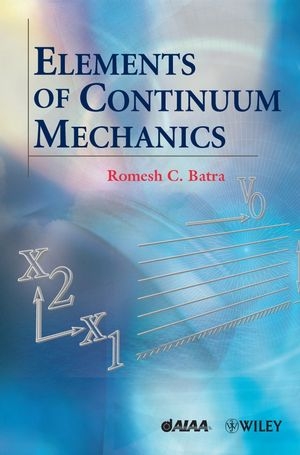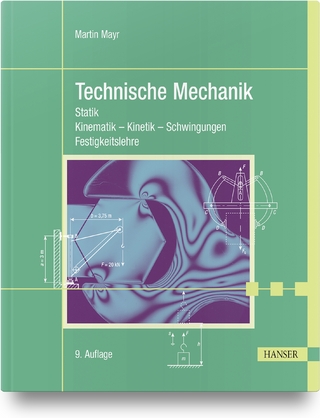
Elements of Continuum Mechanics
John Wiley & Sons Inc (Verlag)
978-0-470-01873-6 (ISBN)
- Titel z.Zt. nicht lieferbar
- Versandkostenfrei innerhalb Deutschlands
- Auch auf Rechnung
- Verfügbarkeit in der Filiale vor Ort prüfen
- Artikel merken
Provides an up to date, practical explanation of continuum mechanics that will appeal to students and practising engineers alike
Features many solved examples and exercises that demonstrate the ideas presented
Correlates ideas with concepts learned in lower level undergraduate classes, in order to make the material more accessible and comprehensible to a wider range of students
Written in a clear and easy-to-read style
Provides a thorough overview of non-linear continuum mechanics
Applications using numerical calculation tools (for example in electronics, materials science and surgery), with mathematical coverage geared towards engineering students
This publication is ideal for 3rd year undergraduates/ graduates, researchers in civil and mechanical engineering, manufacturing engineering, aerospace and geological engineering. Also applied maths advanced undergrad and graduate students, and practising engineers.
ROMESH C. BTARA is the Clifton C. Garvin Professor, Department of Engineering Science and Mechanics, at Virginia Polytechnic Institute and State University. He earned his B.Sc. at Panjabi (now called Thapar) University, Patiala, India, his M.A.Sc. at the University of Waterloo, Canada, and his Ph.D. at the Johns Hopkins University in the U.S. He received the Alexander Von Humboldt Research Award in 1992 and the Reissner Medal from the International Society of Computational Engineering Science, Inc. in 1998 and has published more than 265 articles in peer-reviewed journals. He is a fellow of the American Academy of Mechanics, American Society of Mechanical Engineers, Society of Engineering Science, and American Society of Engineering Education.
Preface. Acknowledgements.
Chapter 1 Introduction.
1.1 What is Mechanics?.
1.2 Continuum Mechanics.
1.3 An Example of an Ad-Hoc Approach.
Chapter 2 Mathematical Preliminaries.
2.1 Summation Convention, Dummy Indices.
2.2 Free Indices.
2.3 Kronecker Delta.
2.4 Index Notation.
2.5 Permutation Symbol.
2.6 Manipulations with the Indicial Notations.
2.7 Translation and Rotation of Coordinate Axes.
2.8 Tensors.
2.9 The Divergence Theorem.
2.10 Differentiation of Tensor Fields.
References.
Exercises.
Chapter 3 Kinematics.
3.1 Description of motion and continuum.
3.2 Referential and Special Descriptions.
3.3 Displacement Vector.
3.4 Restrictions on Continuous Deformation of a Deformable Body.
3.5 Material Derivative.
3.6 Finding Acceleration of a Particle from a Given Velocity Field.
3.7 Deformation Gradient.
3.8 Strain Tensors.
3.9 Principle Strains.
3.10 Deformation of Areas and Volumes.
3.11 Mass Density, Equation and Continuity.
3.12 Rate of Deformation, Strain-Rate Tensor, Spin.
3.13Polar Decomposition.
3.14 Infinitesimal Deformations.
3.15 Infinitesimal Deformations Superimposed Upon Finite.
3.16 Volumetric and Deviatoric Strains.
3.17 Transformation of Tensors Under a Change of Bases.
3.18 Plain Strain Deformation.
Appendix A: Solution of a Cubic Equation.
References.
Exercises.
Chapter 4 The Balance Laws, Stress Tensors.
4.1 Kinetics of a Continuous Media.
4.2 Traction Boundary Conditions.
4.3 The Nominal Stress Tensor.
4.4 Transformation of Stress Tensors Under the Rotation of Axes.
4.5 Principle Stresses; Maximum Shear Stress.
4.6 Relations Among Stress Tensors for Infinitesimal Deformations.
4.7 Plane Stress.
4.8 Deviatoric Stress, von-Mises Stress.
4.9 Balance of Energy.
4.10 Entropy Inequality, The Clausius-Duhem Inequality.
4.11 Summary of Equations Governing Deformations of a Body.
4.12 Nonuniquences of Solutions for Static Problems.
Appendix B: The Transport Theorem.
Exercises.
Chapter 5 Constitutive Relations.
5.1 Introductory Remarks.
5.2 Thermoelastic Material.
5.3 Principle of Material Objectivity.
5.4 Linear Constitutive Relations for Finite Deformations of a Thermoelastic Body.
5.5 Isotropic Thermoelastic Materials.
5.6 Comparison of Results from Four Linear Constitutive Relations in Isotropic Finite Elasticity.
5.7 Transversely Isotropic Thermoelastic Materials.
5.8 Orthotropic Thermoelastic Materials.
5.9 Coincidence of Principle Axes of Stress and Strain in Isotropic Elastic Materials.
5.10 Coincidence of Principle Axes of Stress and Strain in Transversely Isotropic Elastic Materials.
5.11 Incompressible Elastic Materials.
5.12 Comparison of Results fr5om Constitutive Relations.
5.13 Constitutive Relations fro Infinitesimal Deformations of Elastic Materials.
5.14 Constitutive Relations for Special Isotropic Nonlinear Elastic Materials.
5.15 Infinitesimal Deformations Superimposed Upon Finite Deformations of an Isotropic Elastic Body.
5.16 Constitutive Relations for Plane Deformations of a Thermoelastic Body.
5.17 Thermoviscoelastic Materials.
5.18 Summary.
References.
Exercises.
Chapter 6 Torsion of a Circular Cylinder.
6.1 Torsion of a Linear Elastic Circular Cylinder.
6.2 Torsion of a Second Order Elastic Circular Cylinder.
6.3 Infinitesimal Twist of a Finitely Stretched Circular Cylinder.
6.4 Finite Torsion of a Circular Cylinder.
Appendix C: A Uniqueness Theorem.
References.
Exercise.
Chapter 7 Fluid Flow.
7.1 Steady Flow Between Two Parallel Plates.
7.2 Steady Isothermal Flow of an Incompressible Fluid Down an Inclined Plane.
7.3 Steady Flow of an Incompressible Fluid in a Horizontal Circular Pipe.
Exercise.
Chapter 8 Bending of Beams.
8.1 Bending of a Rectangular Beam.
8.2 Bending of a Nonlinear Elastic Rectangular Beam.
8.3 Air Stress Function for Bending of a Beam.
Exercises.
Chapter 9 Wave Propagation.
9.1 Singular Surface.
9.2 Kinematics of a Singular Surface.
9.3 Acceleration Waves in Linear Elasticity.
9.4 Progressive Waves.
9.5 Incompressible Linear Elastic Materials.
9.6 Acceleration Waves in Nonlinear Elastic Bodies.
9.7 Infinitesimal Deformations Superimposed Upon Finite Deformations.
Exercises.
Chapter 10 Spherical and Cylindrical Pressure Vessels.
10.1 Radial Expansion of a Spherical Pressure Vessel.
10.2 Radial Expansion of an Incompressible Hookean Sphere.
10.3 Radial Expansion of a Cylindrical Pressure Vessel.
10.4 Radial Expansion of an Inhomogeneous and Incompressible Hookean Cylinder.
10.5 Finite Radial Expansion of a NeoHookean Cylinder.
Index.
Supporting Materials.
| Erscheint lt. Verlag | 30.9.2005 |
|---|---|
| Verlagsort | New York |
| Sprache | englisch |
| Maße | 156 x 229 mm |
| Gewicht | 680 g |
| Einbandart | gebunden |
| Themenwelt | Naturwissenschaften ► Physik / Astronomie ► Mechanik |
| Technik ► Maschinenbau | |
| Schlagworte | Strömungsmechanik |
| ISBN-10 | 0-470-01873-9 / 0470018739 |
| ISBN-13 | 978-0-470-01873-6 / 9780470018736 |
| Zustand | Neuware |
| Haben Sie eine Frage zum Produkt? |
aus dem Bereich


